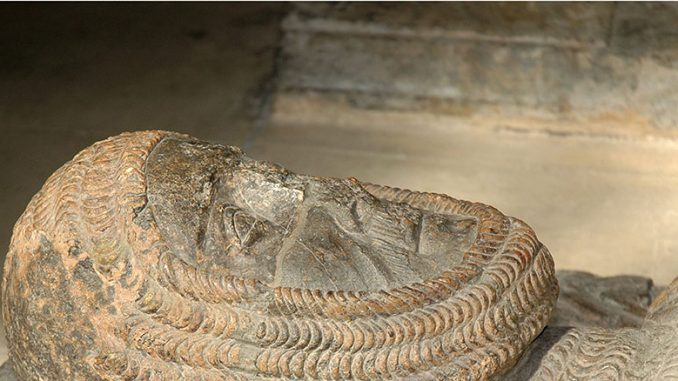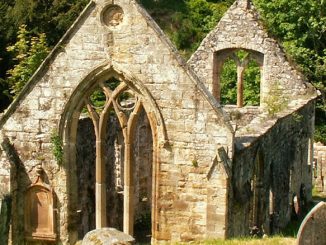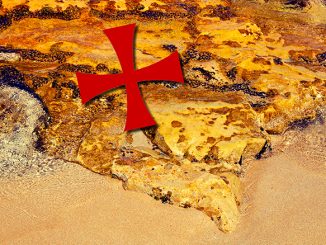
Above: William Marshall statue by Kjetilbjørnsrud
by Alan Butler
Anyone seriously interested in the Knights Templar is likely, at some time in their life, to make a pilgrimage to London, there to visit the district known to this day as ‘Temple’. This area was, in the Middle Ages, the headquarters of the Knights Templar in England and represented a major centre for Templar thought and influence.
Little remains of the buildings placed upon this site, except for the famous Templar Round Church, mentioned elsewhere in this edition. Within the Church there can be found a number of effigies of a very early date, one of which is that of one William Marshall, Earl of Pembroke. William is perhaps not one of the best known characters in either English or Templar history, and this state of affairs is perhaps somewhat regrettable, since, by his life and his honour, he almost certainly represented every ideal for which the Templars, in their early days, became renown.
William Marshall was far from being a simple Templar Knight. He was born around 1146, the second son of John the Marshall, a trusted knight of Norman ancestry, and of Sibyl, who was a sister of Patrick, Earl of Salisbury. Being a younger son, William did not inherit his Father’s titles and so becoming a knight was probably to be expected for one whose proclivities obviously did not extend to high office in the Church. William was duly sent off to Normandy, to be trained by the hereditary Chamberlain of the region, William of Tancarville, and was eventually knighted in the year 1167.
Three years later William Marshall was appointed head of the military household of Prince Henry, the young son of King Henry II of England. Unfortunately Prince Henry died in 1183. As the man who had knighted the Prince, William became his ‘Lord in Chivalry’. William was a physically powerful man who fared well in the tournaments and his time with Prince Henry allowed him to increase his influence with those of the Court who would also prosper in the years that followed.
So upset was William Marshall at the death of Prince Henry, he obtained permission from the King to take Henry’s Cross to Jerusalem. There he spent two years fighting for the King of Jerusalem, who at the time was Guy. It was almost certainly at this time that William Marshall became acquainted with the Knights Templar. Sadly, we have absolutely no reliable evidence as to the nature of his association with the Templars, but his subsequent actions in life betray a close affinity with the White Knights.
William was granted his first land – a ‘fief’ directly from the King, in the year 1187. Upon accepting this gift, William Marshall declared his loyalty to Henry II and his rightful successors. This promise was never forgotten and is the reason William Marshall himself is remembered to this day.
When Henry II’s son, Richard I, came to the throne, William Marshall continued to prosper. He was a councillor, advisor, brother at arms and confidant of the new and vigorous king. So much did Richard trust his brother Templar that he bestowed upon him the hand of Isabel de Clare, who was the only surviving child of Richard Strongbow de Clare, Earl of Pembroke. With this marriage William Marshall became one of the most powerful Barons in England, with lands in England, Wales, Ireland and France.
William ruled his lands well, but unlike many of the Barons of the time, he never forgot his oath of loyalty to his direct feudal lord, Richard I. Nor did William merely ’sit on’ his vast estates, but rather ran them efficiently, built extensively and is known to have been a good and wise ruler to those who now found themselves under his jurisdiction.
With the death of Richard the Lionheart, in 1199, England was thrown into ferment regarding the succession. William considered Richard’s brother John, to have the best claim to the throne, and duly bowed his knee to a man who was to use this loyal knight falsely. King John proved to have absolutely no ability to either ally himself with, or control, the by now powerful Barons of England, many of whom rebelled during John’s unfortunate reign. John took action against many, by either imprisoning them, confiscating their land, or removing their titles.
William Marshall never once faltered in his loyalty to King John, and had already ably served two English monarchs and one heir apparent. Despite this, the despotic King John provoked William beyond reason, taking his castles, and seizing his two sons as hostages.
Despite the most incredible provocation, William Marshall retained his oath of allegiance to King John in a manner that sets him apart. This was a man to whom honour and chivalry were more important than life itself, and remains the prime reason his name is not forgotten like those of many of his brother barons from the period.
There is little doubt that if William Marshall had sided with the rebelling Barons, King John would have lost his crown, and undoubtedly his life but the Earl of Pembroke never wavered and gained tremendous respect from friends and enemies alike.
King John died in 1216. The heir to the throne, who now became Henry III, was a mere nine years of age and William Marshall was unanimously chosen as regent for the young monarch, a position which he filled without prejudice or expectation of any greater influence or preferment. By May 1217, Marshall was the chief architect of victory in the war against King Philip II of France. This magnificent man led an attack, which relieved the siege of Lincoln Castle, despite being seventy years of age. He was able to negotiate a peace treaty with the French and restored England to peace once more.
William Marshall was a man of great courage and physical stamina, but he was much more than a ferocious fighting machine. He proved to several monarchs that he could be a wise councillor, a fiercely loyal servant, and a true friend. By the end of his life his accumulated titles and accolades could fill a page on their own, and yet, it is said, he remained ever humble, espousing, by his life, the best values enshrined in the Order of the Knights Templar.
William Marshall, Earl of Pembroke, and Lord Regent of England, died on May 14th in the year 1219 at the age of 73 years and was buried as a simple Knight of the Temple, in the Temple Church in London. Though he lived in vicious times, and adhered to a code of conduct that few of us could either understand or espouse these days, we may still have much to learn from his sense of honour and his insistence that a promise made was a perpetual oath.
About Us
TemplarHistory.com was started in the fall of 1997 by Stephen Dafoe, a Canadian author who has written several books on the Templars and related subjects.
Read more from our Templar History Archives – Templar History



